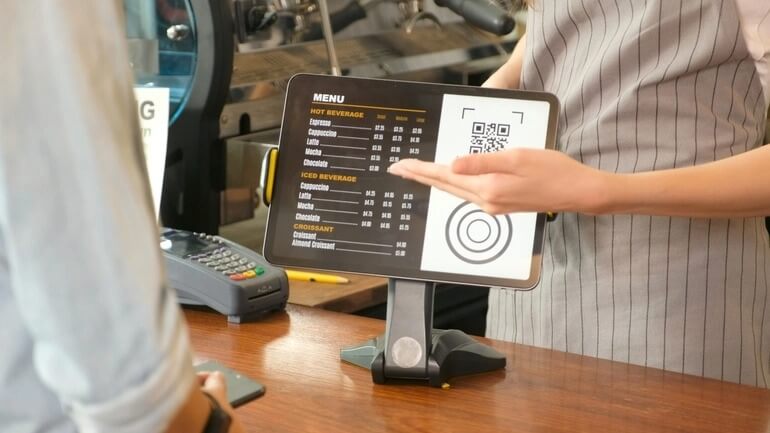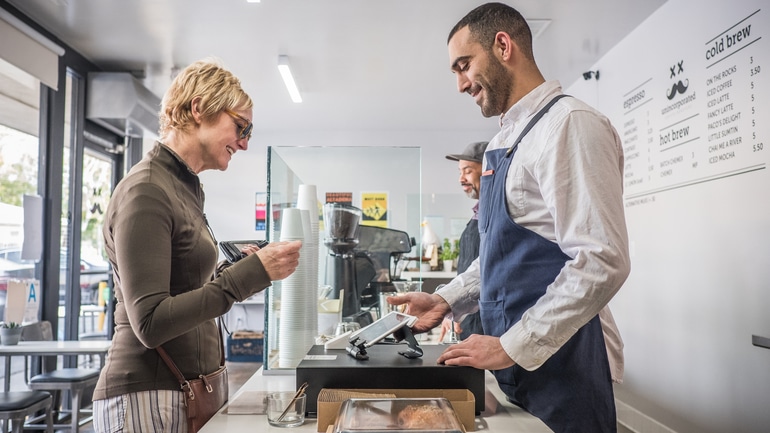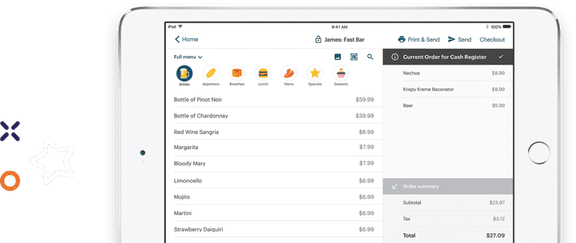There are only a few things worth sacrificing valuable counter space real estate for, and one of them is a point of sale (POS) customer display.
Just as the name suggests, a customer facing display is a digital screen that allows customers to see and confirm their orders in real-time, including menu items, modifiers, and prices. A customer display can dramatically improve the customer experience because it gives guests the opportunity to see the details of their order, ultimately helping to avoid confusion, mistakes, and delays.
But it’s not just your guests that benefit from a customer facing display. For restaurants, using a POS integrated customer display comes with a laundry list of benefits, from increased efficiency to larger check sizes.
If you’re considering a customer facing display for your own restaurant, this article will cover everything you need to know about this powerful piece of restaurant tech, including:
- What is a customer facing display?
- 6 benefits of a POS customer display for restaurants
What is a Customer Facing Display?
Before diving into the details, let’s get one big question out of the way: what is a customer facing display?
A customer facing display is a screen – either a monitor or a tablet – that allows you to display itemized order and payment information to your customers at the point of sale.
Unlike a self-ordering kiosk, the customer does not interact with any of the information on the customer facing display screen or press any buttons – they simply use it as a visual confirmation. A customer display screen can also be customized with your restaurant’s specific branding and used to provide customers with additional information about promotions, your restaurant reward program, new menu items, and more.
It’s also important to note that a customer display is not a standalone piece of technology, but rather, a component of your entire POS system. A customer display runs on the same software as your POS system, so the information staff enters into the POS will automatically be mirrored on the customer facing screen. In most cases, your customer facing display will also be made up of the same hardware as your POS terminals, such as an iPad tablet, but oriented to face the customer.
Customer facing displays are most commonly used by limited service restaurants, such as fast casual and fast food venues, because they can be displayed on the counter where the customer places and pays for their order. In some states, including California, you may even be required to display prices visually as items are rung up during checkout. Be sure to check your local laws to find out if a customer facing display is necessary to keep your business in compliance.

6 Benefits of a Customer Display for Restaurants
While it might seem like more of a nice-to-have than an essential, a customer facing display comes with a lot more benefits for your restaurant than you might realize.
Below are six ways virtually every limited service restaurant can benefit from a POS customer display system:
1. Improves the Customer Experience
One of the most obvious benefits of a point of sale display is the impact on the customer experience.
As a staff member enters a customer’s order information, each item and the price will show up on the customer facing display. This means that the POS display provides the customer with a quick and easy way to check that their order information is correct, including any modifiers or changes. It also lets the customer know how much each item costs and shows any discounts that have been applied.
The transparency that a customer display provides is extremely valuable to customers because it assures them that they will receive exactly what they ordered and how much they’ll be paying for it – information that can go a long way in establishing trust between your staff and your customers.
This sense of trust also comes from a lack of errors. When customers see their order information on the point of sale display, they can easily identify any mistakes. As a result, a POS display significantly reduces the risk of miscommunication between staff and customers, ultimately leading to fewer order errors, voids, and comps. Not to mention, when customers consistently receive the correct order, this reduces the chances of negative customer reviews about your restaurant’s service.
2. Increases Check Sizes
A customer facing display can also be a powerful tool when it comes to restaurant upselling and suggestive selling.
Upselling involves suggesting upgrades or complementary add-ons that increase the total value of a guest’s meal. For instance, you might encourage a guest to add a drink to their meal for just $1 more, or offer to add guacamole to their burrito for a little bit extra. Upselling is easy to do with a customer display because you can visually display different modifiers or combo options at the point of sale – the perfect moment to tempt hungry guests with something extra.
A POS customer display can also contribute to suggestive selling, which involves encouraging guests to buy products that are different from the ones they ordered or would typically order. In this case, you can use a customer display to highlight special offers, promote new menu items, or provide additional menu information. When presented with this additional information at the point of sale, customers can be more easily swayed to change their order.
With seven in 10 customers reporting that they purchased a product or service because a sign caught their eye, visual reminders at the point of sale is a perfect place to influence customer behavior and drive upsells. And at the end of the day, all those larger checks can lead to a big boost in revenue for your business.
3. Faster Ordering Process
If you run a quick service restaurant, you know that speed is an essential part of the guest experience. A customer facing display can speed up the ordering process to ensure that lines at the counter don’t end up stretching out the door.
As mentioned, a POS customer display allows guests to easily and quickly confirm their order information, dramatically reducing the risk of errors. And with fewer order errors, staff will spend less time making last-minute changes or corrections that typically slow down service.
And it’s not just accurate order information that keeps things moving, but also transaction information. When guests can see the full breakdown of their transaction on the POS display, it eliminates conversations with staff about the price of different items or whether certain discounts were applied. And with less time spent checking to make sure a total is correct, lines move significantly faster.
Reducing wait times is crucial to the success of any limited service restaurant, and research shows that even a small decrease can have a big impact on your bottom line. As one study found, just a seven-second reduction in customer wait times increases a fast-casual venue’s market share by as much as 1%. This means that if you become known for being just a little bit faster than your competitors, customers are more likely to return to your restaurant again and again – something that translates to more revenue over time.

4. Enhances Loyalty Programs
Just as a customer display can be used to highlight tasty combos, it can also be used to showcase tempting rewards for your loyalty regulars.
If you use a loyalty software for restaurants, you may be able to use your customer display to show guests important information about the rewards they’ve earned (or are close to earning) with each order. Research has found that 50% of customers will actually change their behavior to reach a higher level in a reward program, so seeing how many points they can earn can encourage higher spend and repeat visits. Not to mention, displaying loyalty information can save time because it helps to answer questions about points and rewards before the customer asks them.
Even if a guest is not a member of your restaurant loyalty program, you can use your customer facing display to encourage them to join. Just knowing your restaurant offers rewards for repeat guests can be enough to encourage someone new to sign up with 68% of customers saying they are “somewhat” or “very likely” to dine at restaurants that offer loyalty programs over those that don’t, according to Software Advice.
5. Boosts Customer Engagement
Researchers have found that customers tend to perceive wait times as shorter when their time is occupied. Customer facing displays are a valuable tool in this sense because they can help to draw attention away from the wait itself and minimize boredom by keeping guests engaged at the point of sale.
For instance, you may be able to configure your customer display to showcase a “Message of the Day” that highlights current events or promotions, new menu items, and other information. You can also pair this message with an eye-catching custom graphic to keep guests engaged at the counter.
Some restaurants may also want to use a point of sale display to showcase their social media profiles and engage customers with their content. For instance, if you have a successful Instagram profile, showing off these images at the point of sale can be a perfect time to catch your customer’s attention and grow your online following.
6. Saves Money on In-Store Advertising
Creating a strong brand presence has never been more important for restaurants and a customer display can help to reinforce the message you want to send to customers.
Most customer facing displays are highly customizable, which means you can adjust the look and feel of your display to match your specific branding. For example, you might change different elements like the font size, colors, logo, and promotional images to make sure your POS display fits your venue (and not the other way around).
In other words, you can consider your POS customer display as a type of digital signage and valuable real estate for your brand message. This means that if you have eye-catching branding at the point of sale, you can spend less money on traditional in-store advertising.
Though customer facing displays have been around for some time now, they’ve never been more valuable to limited service restaurants. Due to changes in technology and diner behavior, there are fewer and fewer opportunities to engage customers and build trust. However, a POS customer display offers a quick and easy way to provide customers with valuable and engaging information that helps to elevate their overall experience. And at the end of the day, a better customer experience translates into more repeat customers and more sales.






